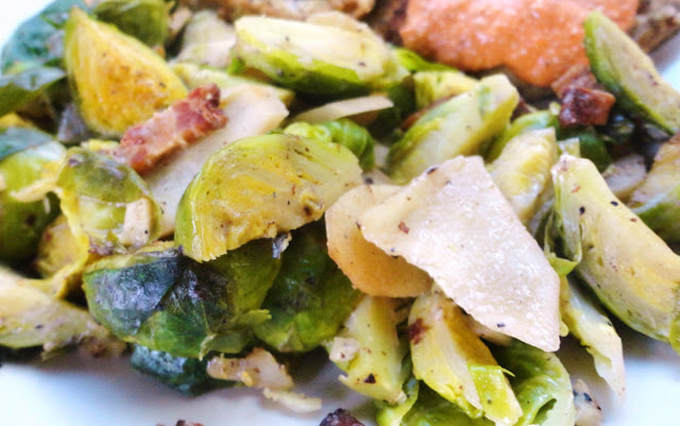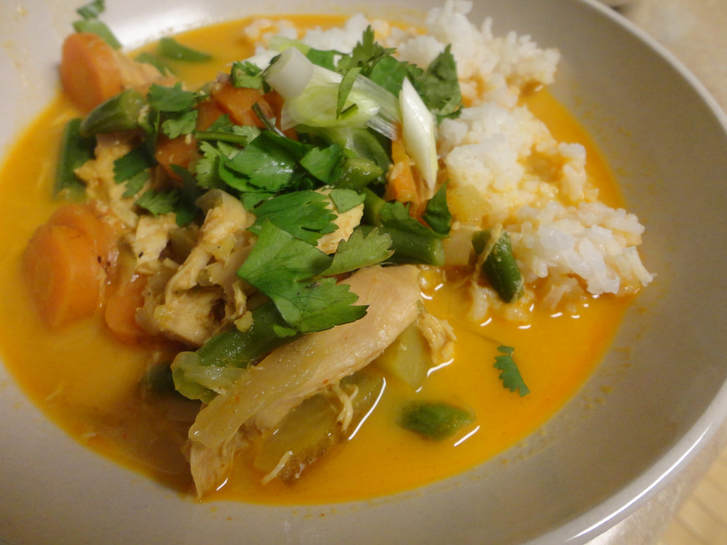|
Cozying up in the winter with a warm, slightly sweet chai tea sounds like a little piece of heaven. This herbal tea recipe takes those delicious spices found in traditional chai, and adds herbs that nourish and support the adrenals. I left out the black tea that is in traditional chai blends, because of the caffeine content. I am not opposed to caffeine altogether, but when getting things like stress and blood sugar into balance, it can be helpful to limit your intake. The warming spices found in chai tea blends are great for the winter time, especially to stoke your inner fire, or agni, as it is called in the Ayurvedic tradition. Foods and beverages that are warming promote circulation and digestion, both important during the cold winter months to stay healthy. The benefit to the adrenals comes from the adaptogenic herbs. The ashwagandha, licorice and eleuthero are all adaptogenic herbs, meaning they help the body respond to stressors in a more healthful way; their purpose is to help the body adapt. They help you bounce back from stress at work or the flu or polluted air in the city. Adaptogens support the adrenal glands and, more accurately, the whole HPA (hypothalamic-pituitary-adrenal) axis. They help to balance stress hormones, improve energy levels, promote better sleep, and boost immune function. These herbs are tonics, meaning they are safe for most people to use over long periods of time. "Adaptogens: Herbs for Strength, Stamina, and Stress Relief" by David Winston and Steven Maimes is a great book to read if you want to learn more about these herbal remedies. When the HPA axis is out of whack, you can have blood sugar dysregulation and weight gain, and even negatively impact your thyroid function. If you have experienced a lot of recent stress, or on the extreme end, HPA axis dysfunction or hypothyroidism, adaptogens may be beneficial herbs for you to try. Luckily, this tea is an easy and delicious way to get these herbs into your life. When you are working on improving your adrenal health, it is also important to focus on practicing stress-reduction methods such as meditation or long walks in nature. In the diet, be sure to get plenty of vitamin C (from fruits and vegetables, or herbs like amla and rose hips), rest, light, and appropriate exercise. Ensuring adequate nutrient intake, including calories and the macronutrients, is also important. Adaptogenic herbs are part of a larger picture, and give the body extra support as you work on stress and nourishment for your adrenal function. For more information on HPA axis dysfunction, I recommend checking out the work from The Ancestral RD's, on their blog or podcast. Adrenal Tonic Chai Tea
Caffeine-Free (Serves 2-3) 8 star anise pods 3 cinnamon sticks, 2-3" long each 1-2" grated fresh ginger (or 1 Tbs chopped dried ginger) 6 cardamom pods, crushed 2 tsp fennel seeds 1 Tbs black peppercorns 1 Tbs whole cloves 1 Tbs licorice root 2 Tbs ashwagandha 2 Tbs eleuthero root 1 1/2 quarts filtered water (*all herbs measured in dry form) Honey and heavy cream or coconut milk to taste Place all herbs together in a 2 quart stainless steel pot. Cover and bring to a boil. Reduce heat to low and let simmer 15-30 minutes, simmering longer for a stronger, more flavorful tea. Strain tea and add honey and cream to taste.
0 Comments
If you are looking for a satisfying winter vegetable side dish, this may become your new favorite. Brussels sprouts might actually be my favorite vegetable, so I am always trying to find new ways to incorporate them into my meals. Not only do they taste great, but they are also rich in sulfur, which supports the body's detoxification process. On their own, they are strongly-flavored enough to stand up to strong flavors like bacon and lemon. But I add another element in this recipe with the starchy salsify root, for another layer of texture and flavor. If you are unfamiliar with salsify, it may be time to try it out. Salsify is also known as "oyster root," as it has a slightly mineral-y, oyster-like flavor to it. It is a hearty root, and it's high in minerals like manganese, as well as B vitamins. You will be hard-pressed to find it at a conventional grocery store, but try looking at a health food store or winter farmer's market. Salsify also grows wild here in our area of Wisconsin, so you can wild harvest it as well! Find a good foraging book to accurately identify it in the wild, and you can avoid the store altogether. I like Samuel Thayer's new book, Incredible Wild Edibles, which talks about salsify foraging. Salsify is a root vegetable which, unpeeled, looks a lot like burdock root or even a thin, dark parsnip. It is actually a part of the sunflower family, though you may not know it by it's appearance. Once peeled, you can eat it raw or cooked, like in this recipe. This dish calls for thinly slicing on the bias, to create a nice oblong shape. You could also shred it and put it in slaws, latkes or stir fries. If you are unable to find salsify, you can substitute parsnips in the same quantity, with no need to peel if they're organic and unwaxed. Either way, this is a great side dish for roast or other hearty main dish, and you could serve the leftovers for breakfast with over-easy eggs on top! Brussels Sprouts and Salsify with Bacon and Lemon Cream
(serves 4-6) 1 Tbs grass-fed butter 2 lbs Brussels sprouts, trimmed and quartered 2 cups salsify root, peeled and thinly sliced on the bias--or substitute parsnip 1/2 cup shallots, thinly sliced 2 cloves garlic, minced 4 strips uncooked bacon, chopped 1/2 cup bone broth, or can substitute water 1/2 tsp sea salt or to taste 1/4 tsp black pepper Big pinch of red pepper flakes Juice of 1 lemon (about 1/4 cup) 1/2 cup organic sour cream or creme fraiche In a large skillet, heat butter over medium flame until melted. Add sliced salsify to the pan and cook 3-5 minutes, stirring frequently, until becoming slightly browned. Add bacon and shallots to the pan. Cook 5 more minutes until the bacon begins to get about halfway "done." Add the Brussels sprouts and garlic and saute 2-3 more minutes to brown edges. Add broth, along with salt, pepper and red pepper flakes. Cover and turn to low; let simmer 5-10 more minutes until sprouts begin to soften and the liquid has reduced by at least half. While the veggie mixture is cooking, whisk the lemon juice, sour cream and an extra pinch of salt together in a small bowl. When the veggies are tender and the bacon is fully cooked, remove from the heat. Add the lemon cream to the pan and stir to coat the vegetables. Serve garnished with a pinch of red pepper flakes. With the brutal cold we've been experiencing lately, I am all about the soups and stews. This rich coconut milk-based Thai curry is perfect on a cold winter night, with a little bone broth added in for good measure. This is one of my favorite ways to use up chicken breasts when we buy a rotisserie chicken from the co-op, as the legs and dark meat are the parts we really want to eat and always have the breasts left over. If you don’t have rotisserie chicken, you can use any leftover chicken, or roast skin-on chicken breasts until fully cooked before preparing this recipe. You can use any combination of vegetables you like here, but I have given some suggestions below in the recipe. If Thai basil is hard to find, you can use fresh cilantro as your fragrant green garnish instead. For brands of the packaged foods used, I suggest Native Forest or Natural Value coconut milks, as they have no additives, are organic, and come in BPA-free cans. We use Red Boat fish sauce, but Thai Kitchen is also a good choice. I use Thai Kitchen curry pastes, but you can use any brand you like…leave a comment if there is one I have to try! The directions here for the rice involve soaking it in a slightly acidic water, made from adding liquid whey drained from yogurt. This increases the digestibility and nutritional value of the rice, by decreasing the content of phytic acid. If you forget this step, don’t sweat it, but it is totally worth it if you get a chance to soak the rice in the morning, then it will be ready to cook for dinner. This is even great the next day to take in your lunch and make your co-workers jealous, or for a quick weeknight meal of leftovers. Thai Red Curry with Chicken Serves 4-6 1 Tbs coconut oil 1 medium onion 2 cloves garlic 2" ginger, grated optional: 1/2" galangal root, grated 1 can full fat coconut milk 4 Tbs Thai red curry paste 1 1/2 cups chicken broth, homemade preferred 2 cooked and roughly-chopped chicken breasts –skin on preferred (I use the chicken breasts from the rotisserie chicken at our coop, but you could cook yours ahead of time if desired) 3-4 cups of various vegetables—I like a combination of potatoes, bell peppers, carrots, mushrooms, green beans, and broccoli 1/2-1 tsp fish sauce to taste 2 Tbs lime juice 2 Tbs coconut sugar or honey To serve: Big handful of Thai basil or cilantro, roughly chopped Sliced scallions Lime wedges Sriracha and fish sauce Soaked Rice:
1 cup white or brown jasmine rice 2 cups water pinch sea salt 1 Tbs whey, drained from plain yogurt, or yogurt For the rice: The morning before you prepare the curry (if making for dinner), soak the rice in the water, along with the salt and whey. Let this sit 6-8 hours to remove phytic acid and increase the digestibility of the rice. To cook, drain and rinse the soaked rice. Combine with 2 cups of fresh water and a pinch of salt in a medium sauce pan. Bring to a boil, reduce to simmer and cover. Let simmer, without stirring or removing lid, for 20-25 minutes. Remove from heat and let sit 5 more minutes, covered, then fluff with a fork. Alternately, you can prepare in a rice cooker according to manufacturer’s directions. While the rice cooks, prepare the curry: Heat coconut oil over medium heat in a pan or stock pot. Add the onion and saute 3-5 minutes until they begin to become translucent. Add the garlic and ginger (and galangal if using). Saute for 3-5 more minutes until they start to cook down. Add the coconut milk, broth and curry paste. Bring to a boil. Reduce to a simmer and add the prepared chicken and the vegetables. If using bell peppers or broccoli, wait to add until toward the end of cooking, after 8 or so minutes. Simmer chicken and vegetables in the coconut milk base for 10-15 minutes, until the vegetables have softened and the coconut milk has thickened slightly. Add the fish sauce, coconut sugar and lime juice and let cook 2-3 more minutes. Serve with prepared rice, garnished with Thai basil or cilantro and scallions, with extra fish sauce, lime wedges, and Sriracha hot sauce on the side. |
Brine & Broth
I am a gut health-focused nutritionist and online health coach based in Southwest Wisconsin. My recipes and philosophies center around traditional, nutrient-dense foods that support robust gut health. Archives
May 2022
Categories |







 RSS Feed
RSS Feed
